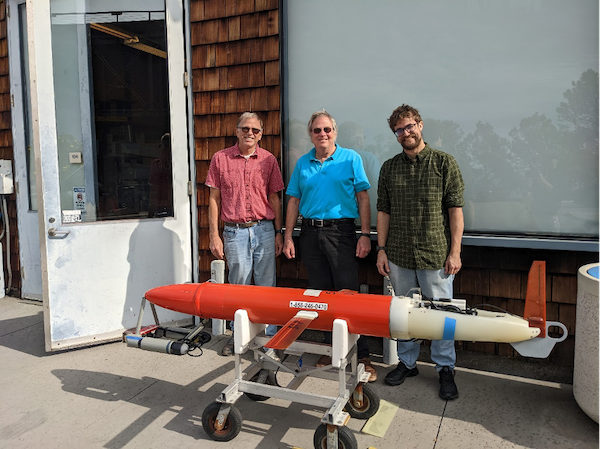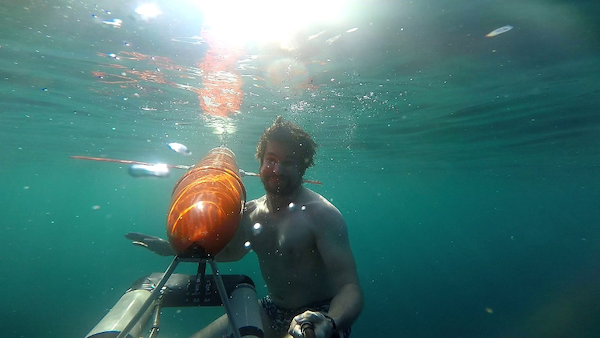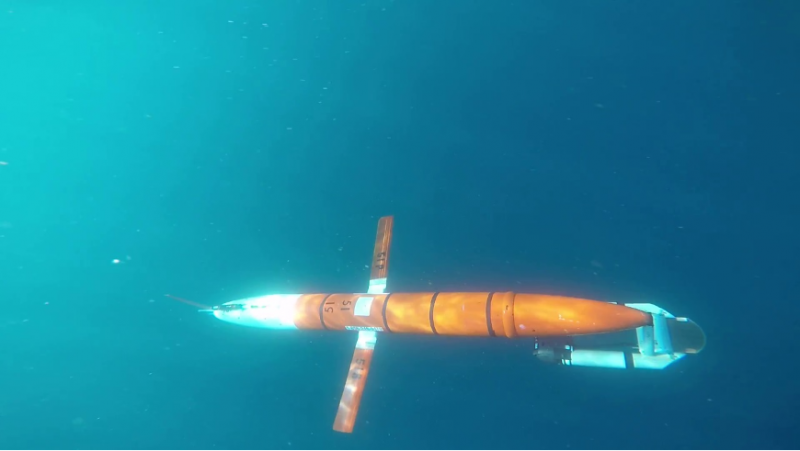The Zooglider
As part of the BioSWOT-Med campaign, Sven Gastauer is in charge of the Zooglider, a glider specialising in the study of mesozooplankton. He describes how it works, the different instruments that are mounted on it and the wide range of data that can be collected.

Zooglider with Jeff Sherman, Mark Ohman, Sven Gastauer (left to right) at the Scripps Institution of Oceanography.
OCEANOGRAPHERS' INSTRUMENTS - Sven Gastauer is a senior researcher in acoustics at the Institute for Marine Fisheries in Thünen, Germany, and a visiting scientist at the Scripps Institution of Oceanography (University of California, San Diego) in the United States. As part of the BioSWOT-Med campaign, he is in charge of Zooglider, a glider specialising in the study of mesozooplankton.
What are your research interests outside BioSWOT-Med?
My research focuses on hydroacoustics as a tool to better understand ecological and biological processes. This often involves coupling hydroacoustics with ancillary data sources, such as biological samples, optics and physical measurements. This requires me to constantly deepen my understanding of acoustic signals, which has led me to take a keen interest in acoustic scattering models.
What is zooplankton glider?
The Zooglider is a specialised glider designed to improve our understanding of mesozooplankton. Many species of zooplankton are fragile or gelatinous animals that are difficult to sample or observe using traditional methods such as nets. Zooglider is designed to be as stealthy as possible underwater, causing as little turbulence as possible so as not to disturb marine organisms in their natural behaviour.
The Zooglider is usually deployed by two or three people. Once released into the water, it is autonomous. The Zooglider has no engine or external moving parts. As a glider, it is equipped with a small oil bladder. A built-in pump will pump oil from or into this bladder, causing a slight variation in the glider's overall density, resulting in an upward or downward force. The presence of wings creates lift, which allows the glider to swim up or down the water column at a given angle, thus moving along the seabed. A typical dive takes place at depths of up to 400 m and lasts around 3 hours. When the Zooglider reaches the surface, it raises one of its wings to establish a satellite link with the shore. This is how it lets us know that all is well and sends us a summary of what it observed on its last dive.
How does the Zooglider work?
Based on Zooglider's last position, we combine the information provided by the satellites about the features we might want to sample with the subsequent report we receive from Zooglider, to decide whether we want it to continue on its pre-programmed trajectory or whether we want to give it a new destination. This routing process is constantly revised during a mission. In the case of BioSWOT-Med, I will be closely monitoring the information received and negotiating the next waypoint with Professor Mark Ohman of the Scripps Institution of Oceanography. Once we have agreed on our next destination, Dr Jeff Sherman of the Scripps Institution's development group will send the commands to the Zooglider via a satellite link.
Zooglider underwater.
What data does Zooglider acquire?
During the descent, Zooglider is in passive mode, recording only the ambient sounds of the sea using a hydrophone. During the ascent, Zooglider collects CTD information - temperature, salinity and chlorophyll fluorescence (as an indicator of phytoplankton concentration), which allows us to obtain detailed information about the physical environment in which Zooglider evolves.
But the ocean is not just physical, and we also want to understand the drifting planktonic organisms at the base of the ocean food web. This is why we have equipped Zooglider with a specialised optical system called Zoocam. The Zoocam is a shadow imaging system which, as its name suggests, records the shadows of everything Zooglider comes across on its travels. A red LED beam (grouped and parallelized to eliminate any spatial distortion) is projected through a sampling tunnel of around 250 ml, attached to the glider's cast iron. Anything that passes through this light beam casts a shadow, which is then recorded by the camera. This allows us to quantitatively record dense organisms, such as small crustaceans, as well as translucent gelatinous organisms, such as jellyfish, siphonophores or marine snow. Because ambient light is very weak at depths greater than a few metres, many organisms do not rely solely on their optical senses, but use sound as a means of communicating and detecting their environment.
Zooglider is also equipped with a dual-frequency active acoustic system called Zonar. The Zonar emits acoustic waves at 200 and 1000 kHz and waits for the signal to return. A sound wave travels much faster underwater than in the air. On its way through the water column, any object or organism it encounters sends some of the acoustic energy back to its source. In very general terms, the signal received at higher frequencies will be more dominated by smaller organisms and the signal at lower frequencies will be more dominated by larger organisms. This technique is very similar to that used by dolphins to find their prey and friends and to avoid potential obstacles. This last point prompted us to integrate a seabed detection algorithm into Zooglider, enabling it to detect the presence of the seabed and automatically adjust its trajectory if it comes too close to it. Using a combination of acoustic scattering models and information received from the zonar and zoocam, we can separate the acoustic signal into organisms of different size classes or taxonomic groups. Combined with observations of the physical environment and images from the zoocam, this allows us to detect changes in the density or composition of mesozooplankton communities.
How do you use the Zooglider's hydrophone to listen to the calls of marine mammals and fish?
Many marine organisms are highly vocal, communicating through sound. A hydrophone is an underwater microphone that allows us to listen to the chatter of sound-producing animals such as marine mammals or fish. It is well known that whales have different songs or types of call that they use to communicate. For example, we can distinguish between different species of baleen whales by the calls they produce, and we can often even understand whether they are making social, feeding or mating calls. Less well known is the fact that many fish are also highly vocal. Admittedly, the sound of a chorus of fish is not as melodious or relaxing as that of a humpback whale, and is more of a growl. Nevertheless, these sounds can shed light on fish behaviour. While marine mammals produce sound using mechanisms similar to our own, fish mainly produce sound through sonic muscles located on or near their swim bladder, through the friction of skeletal components or, more passively, through sudden changes in swimming direction or speed. On Zooglider, we recently added an Acousonde, a kind of highly portable hydrophone. We've pre-programmed the hydrophone so that it starts recording when the glider reaches a certain depth and stops when the Zooglider starts to ascend. We use the descent for our listening session, as this is when the Zooglider is at its quietest, with no other instrument noise. After the journey, we can listen to all the conversations that Zooglider recorded during its mission.
You can follow Zooglider in real time via a public website.

Sven Gastauer and Zooglider.
Contact us: Tosca Ballerini
More information





